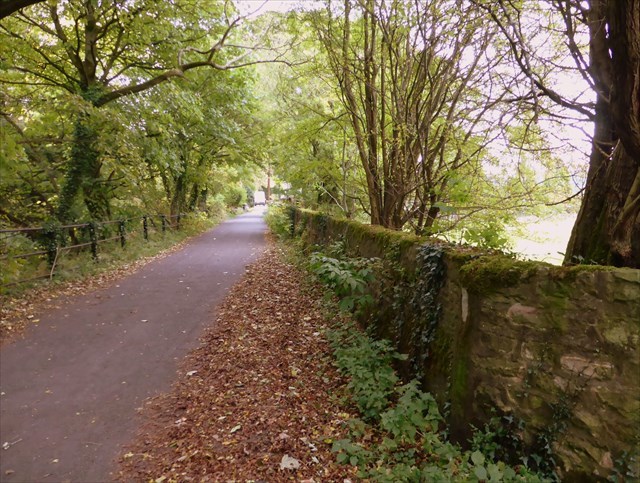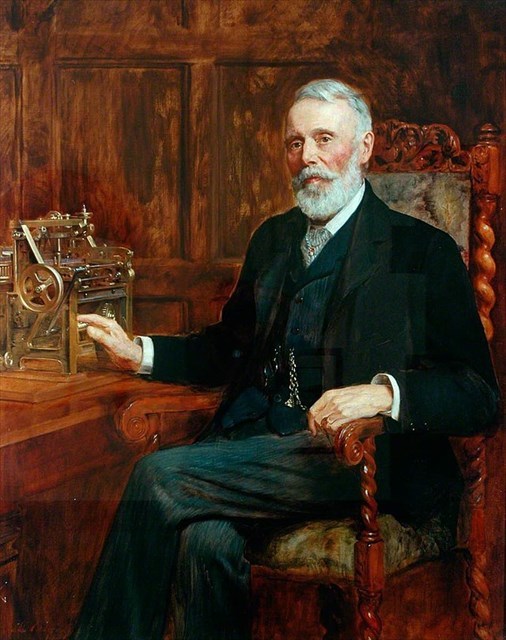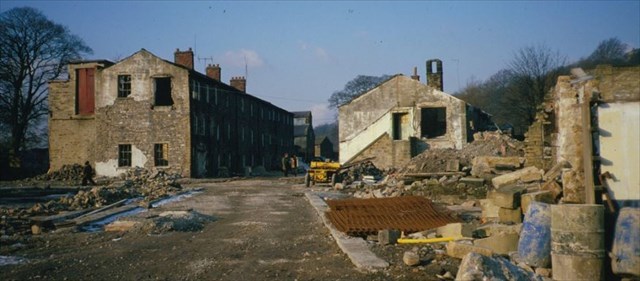WRW #19: Low Mill Lane

The cache, a 35mm film pot, is hidden in the mossy wall about half way along this lane which runs from Addingham Church Street to the village of Low Mill (Fold).
To reach the cache location:either a) park at or near N 53 56.521 W 1 52.366 roadside on Church Street, Addingham and approach from the west or b) park at or near N 53 56.359 W 1 51.734 roadside on Old Lane and approach from the east, passing through Low Mill Fold. Both are around 400m walk.
History of Low Mill (Part 2)
 Horsefall now [1826] had the opportunity build a new and larger mill, the New End, to the west of the Old End. He re-equipped the mill for mule spinning and later brought in power looms without [any more] protest - the Addingham workforce was content. When the New End was built he added another water wheel which survived until 1938 when a new turbine was installed.
Horsefall now [1826] had the opportunity build a new and larger mill, the New End, to the west of the Old End. He re-equipped the mill for mule spinning and later brought in power looms without [any more] protest - the Addingham workforce was content. When the New End was built he added another water wheel which survived until 1938 when a new turbine was installed.
In 1827 he made a gas works for supplying lighting initially to the mill and hamlet of Low Mill, but soon for all the other Addingham mills and the village. In 1835 he installed a 34 hp steam engine but then in 1841 unexpectedly ceased trading which led to a significant drop in the Low Mill population.
In 1842 William Threlfall and William Seed took out a 21-year lease and continued spinning cotton for nine years. In 1859 they went bankrupt, and the mill ceased working again. In 1850 the owners of Low Mill were the brothers and sisters of the Cunliffe-Listers. Samuel Cunliffe-Lister took over the lease, Samuel who had already persuaded his father to build a mill in Manningham was a very inventive young man, he had identified combing as being the major bottleneck in worsted yarn production.
In 1851 he achieved success by carding the wool before combing it with his machine which he patented. Samuel after taking over Low Mill continued cotton spinning. In 1855 he took on a new project with a partner called Warburton trying to comb silk, he was initially unsuccessful and after time Warburton withdrew from the project by selling his 20% to Samuel Cunliffe - Lister.
By the late 1860s the process was improved to become economically viable. Up until 1870 the weaving of velvets was by hand. Again in 1878, Samuel and his partner Reixach perfected and patented a power loom [cut pile] for weaving velvets. These inventions had a dramatic effect on employment, of the 120 hand combers in 1851 only 13 remained in 1861. In 1894 the 55 velvet cutters which were employed at Low Mill dwindled sharply as the effectiveness of the machines were improved.
In 1871 the Lister household moved from Bradford to Farfield Hall and donated Lister Park and its mansion to Bradford. By the turn-of-the-century Listers owned five mills in Addingham, and the operations at Low Mill carried on spinning and weaving velvets.
During WW1 Low Mill produced cordite silk. Listers diversified into Botany Wools and in 1926 a 3-storey mill was built at Low Mill. Later, Listers entered into a partnership with the Peltzers of Crefeldt Germany weaving velvet in the UK to avoid tariffs. When WW2 broke out the German workers were interned on the Isle of Man.
In 1941, after the S.U. carburettor factory in Coventry was bombed, production of the carburettors was moved to Addingham at the Low Mill factory. Up to 1,000 people worked there and a number of prefabricated houses were erected in Ilkley to house them. The other textile factories were busy during the war using Listers expertise in silk to make such things as parachute silk.
 After the war carburettor production ceased and Low Mill returned to textiles. But textiles in Britain never really recovered after WW2. For a short time, the mills were working hard, as textiles were in short supply. Unfortunately, the machinery was out of date and as the Continental factories re-equipped the British textile industry found itself on hard times. There was a major closure of textile mills and many of Listers mills closed including Low Mill where spinning ceased in 1967 and remaining operations including the weaving shed in 1976.
After the war carburettor production ceased and Low Mill returned to textiles. But textiles in Britain never really recovered after WW2. For a short time, the mills were working hard, as textiles were in short supply. Unfortunately, the machinery was out of date and as the Continental factories re-equipped the British textile industry found itself on hard times. There was a major closure of textile mills and many of Listers mills closed including Low Mill where spinning ceased in 1967 and remaining operations including the weaving shed in 1976.
In the 1980s the houses and Old End at Low Mill were modernised and converted into luxury cottages. In 1998/99 textiles returned to Low Mill in the form of a 'state-of-the-art' wool scouring plant owned by a Norwegian company Straume, but this closed in 2002 after only a short period of operation following fierce opposition from local villagers. The official reason given was that the site was not viable (too small) for the company's needs. The site has now been largely replaced by housing known as Low Mill Fold.
See here for more information on, and history of, Addingham village and here for a short video on Addingham: Founding of the Yorkshire Textile Industry.